trailer VOLKSWAGEN POLO 2015 OwnerôÇs Manual
[x] Cancel search | Manufacturer: VOLKSWAGEN, Model Year: 2015, Model line: POLO, Model: VOLKSWAGEN POLO 2015Pages: 100, PDF Size: 4.14 MB
Page 6 of 100
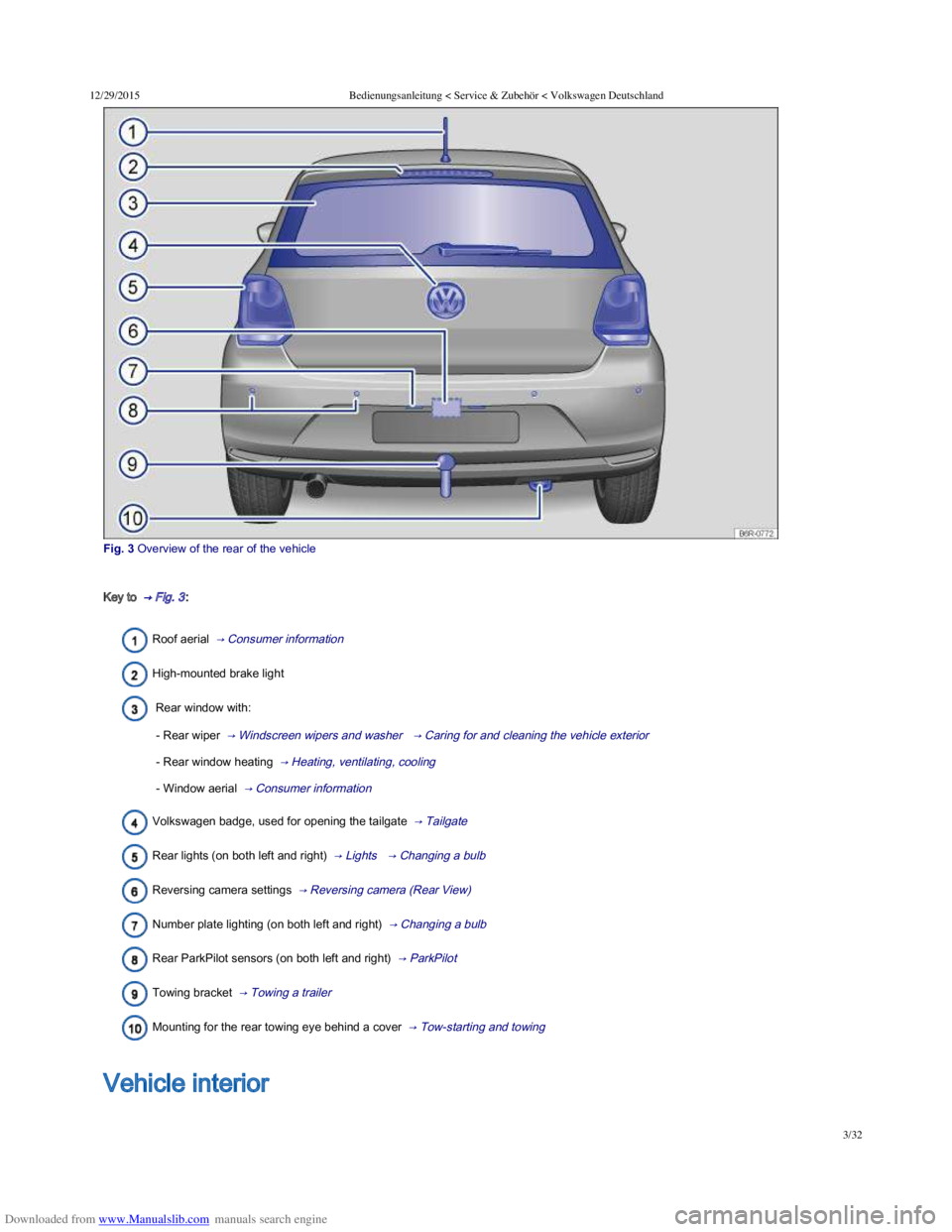
Downloaded from www.Manualslib.com manuals search engine 12/29/2015Bedienungsanleitung < Service & ZubehûÑr < Volkswagen Deutschland
3/32
Fig.ô 3ô Overviewô ofô theô rearô ofô theô vehicle
Key to ô ãô Fig.ô 3ã₤:
Roof aerial ô ãô Consumer information ã₤
High-mounted brake light
Rear window with:
- Rear wiperô ô ãô Windscreen wipers and washer ã₤ ô ãô Caring for and cleaning the vehicle exterior ã₤
- Rear window heating ô ãô Heating, ventilating, cooling ã₤
- Window aerial ô ãô Consumer information ã₤
Volkswagen badge, used for opening the tailgate ô ãô Tailgate ã₤
Rear lights (on both left and right) ô ãô Lights ã₤ ô ãô Changing a bulb ã₤
Reversing camera settings ô ãô Reversing camera (Rear View) ã₤
Number plate lighting (on both left and right) ô ãô Changing a bulb ã₤
Rear ParkPilot sensors (on both left and right) ô ãô ParkPilot ã₤
Towing bracket ô ãô Towing a trailer ã₤
Mounting for the rear towing eye behind a cover ô ãô Tow-starting and towing ã₤
Overview of the driver door
Vehicle interior
Page 15 of 100
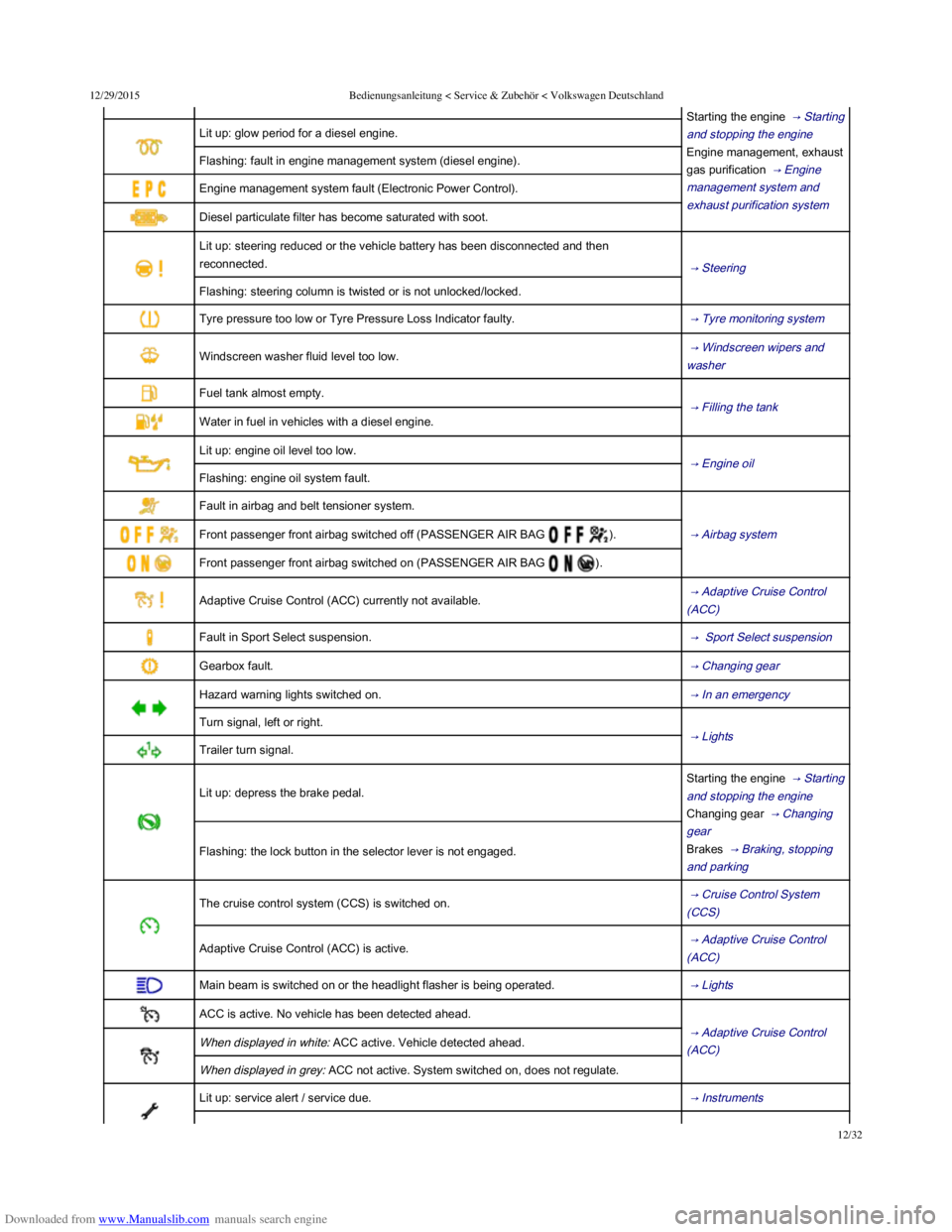
Downloaded from www.Manualslib.com manuals search engine 12/29/2015Bedienungsanleitung < Service & ZubehûÑr < Volkswagen Deutschland
12/32
Starting the engine ô ãô Starting
and stopping the engine ã₤
Engine management, exhaust
gas purification ô ãô Engine
management system and
exhaust purification system ã₤
Lit up: glow period for a diesel engine.
Flashing: fault in engine management system (diesel engine).
Engine management system fault (Electronic Power Control).
Diesel particulate filter has become saturated with soot.
Lit up: steering reduced or the vehicle battery has been disconnected and then
reconnected.ô ãô Steering ã₤
Flashing: steering column is twisted or is not unlocked/locked.
Tyre pressure too low or Tyre Pressure Loss Indicator faulty.ô ãô Tyre monitoring system ã₤
Windscreen washer fluid level too low.ô ãô Windscreen wipers and
washer ã₤
Fuel tank almost empty.
ô ãô Filling the tank ã₤
Water in fuel in vehicles with a diesel engine.
Lit up: engine oil level too low.
ô ãô Engine oil ã₤
Flashing: engine oil system fault.
Fault in airbag and belt tensioner system.
ô ãô Airbag system ã₤ Front passenger front airbag switched off (PASSENGER AIR BAG ô ).
Front passenger front airbag switched on (PASSENGER AIR BAG ô ).
Adaptive Cruise Control (ACC) currently not available.ô ãô Adaptive Cruise Control
(ACC) ã₤
Fault in Sport Select suspension.ô ãô Sport Select suspension ã₤
Gearbox fault.ô ãô Changing gear ã₤
Hazard warning lights switched on.ô ãô In an emergency ã₤
Turn signal, left or right.
ô ãô Lights ã₤
Trailer turn signal.
Lit up: depress the brake pedal.
Starting the engine ô ãô Starting
and stopping the engine ã₤
Changing gear ô ãô Changing
gear ã₤
Brakes ô ãô Braking, stopping
and parking ã₤
Flashing: the lock button in the selector lever is not engaged.
The cruise control system (CCS) is switched on.ô ãô Cruise Control System
(CCS) ã₤
Adaptive Cruise Control (ACC) is active.ô ãô Adaptive Cruise Control
(ACC) ã₤
Main beam is switched on or the headlight flasher is being operated.ô ãô Lights ã₤
ACC is active. No vehicle has been detected ahead.
ô ãô Adaptive Cruise Control
(ACC) ã₤When displayed in white: ACC active. Vehicle detected ahead.
When displayed in grey: ACC not active. System switched on, does not regulate.
Lit up: service alert / service due.ô ãô Instrumentsã₤
ô ãô Changing gear ã₤
Page 37 of 100
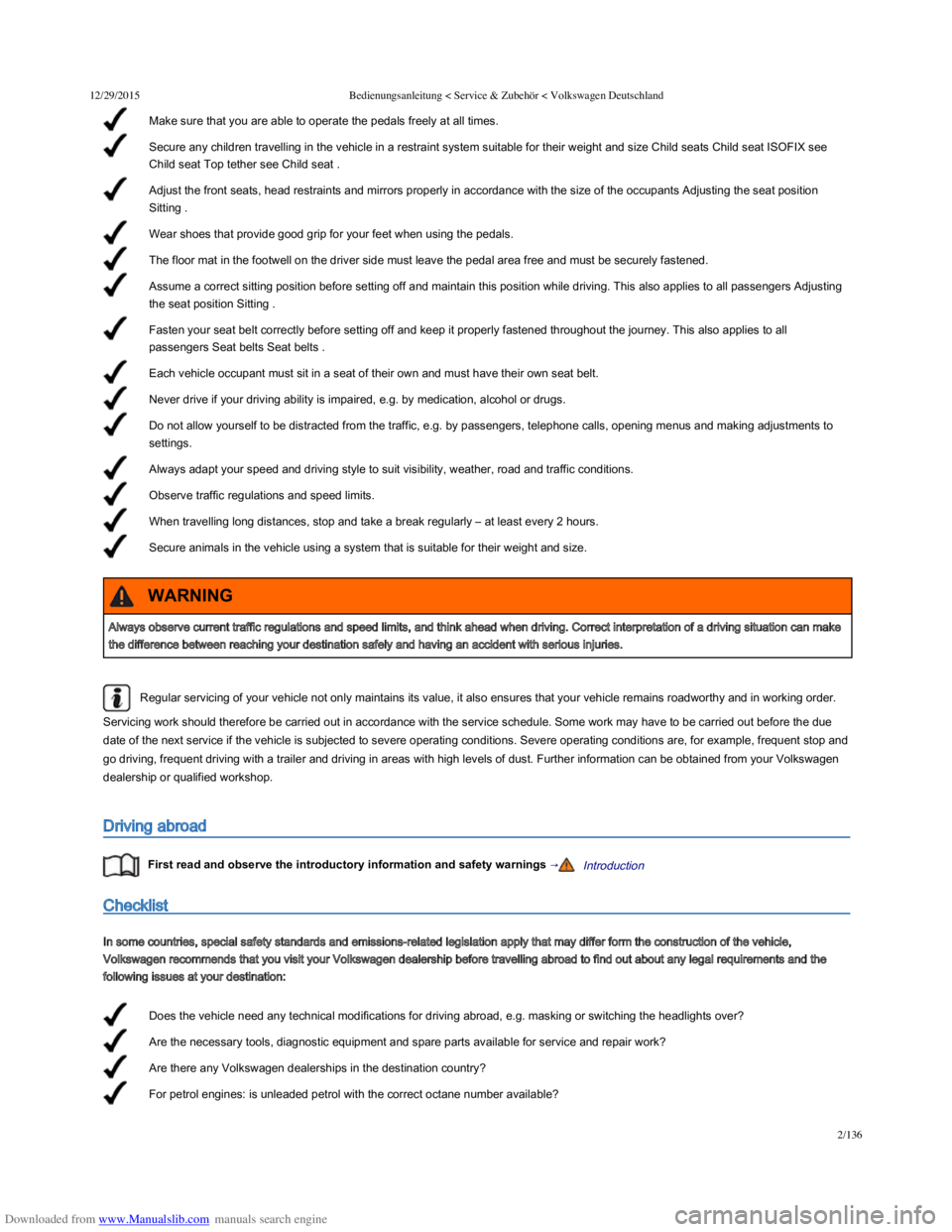
Downloaded from www.Manualslib.com manuals search engine 12/29/2015Bedienungsanleitung < Service & ZubehûÑr < Volkswagen Deutschland
2/136
Make sure that you are able to operate the pedals freely at all times.
Secure any children travelling in the vehicle in a restraint system suitable for their weight and size Child seats Child seat ISOFIX see
Child seat Top tether see Child seat .
Adjust the front seats, head restraints and mirrors properly in accordance with the size of the occupants Adjusting the seat position
Sitting .
Wear shoes that provide good grip for your feet when using the pedals.
The floor mat in the footwell on the driver side must leave the pedal area free and must be securely fastened.
Assume a correct sitting position before setting off and maintain this position while driving. This also applies to all passengers Adjusting
the seat position Sitting .
Fasten your seat belt correctly before setting off and keep it properly fastened throughout the journey. This also applies to all
passengers Seat belts Seat belts .
Each vehicle occupant must sit in a seat of their own and must have their own seat belt.
Never drive if your driving ability is impaired, e.g. by medication, alcohol or drugs.
Do not allow yourself to be distracted from the traffic, e.g. by passengers, telephone calls, opening menus and making adjustments to
settings.
Always adapt your speed and driving style to suit visibility, weather, road and traffic conditions.
Observe traffic regulations and speed limits.
When travelling long distances, stop and take a break regularly ã at least every 2ô hours.
Secure animals in the vehicle using a system that is suitable for their weight and size.
Does the vehicle need any technical modifications for driving abroad, e.g. masking or switching the headlights over?
Are the necessary tools, diagnostic equipment and spare parts available for service and repair work?
Are there any Volkswagen dealerships in the destination country?
For petrol engines: is unleaded petrol with the correct octane number available?
Regular servicing of your vehicle not only maintains its value, it also ensures that your vehicle remains roadworthy and in working order.
Servicing work should therefore be carried out in accordance with the service schedule. Some work may have to be carried out before the due
date of the next service if the vehicle is subjected to severe operating conditions. Severe operating conditions are, for example, frequent stop and
go driving, frequent driving with a trailer and driving in areas with high levels of dust. Further information can be obtained from your Volkswagen
dealership or qualified workshop.
Driving abroad
Firstô readô andô observeô theô introductoryô informationô andô safetyô warningsô ãIntroductionã₤
Checklist
In some countries, special safety standards and emissions-related legislation apply that may differ form the construction of the vehicle,
Volkswagen recommends that you visit your Volkswagen dealership before travelling abroad to find out about any legal requirements and the
following issues at your destination:
Always observe current traffic regulations and speed limits, and think ahead when driving. Correct interpretation of a driving situation can make
the difference between reaching your destination safely and having an accident with serious injuries.
WARNING
Page 40 of 100
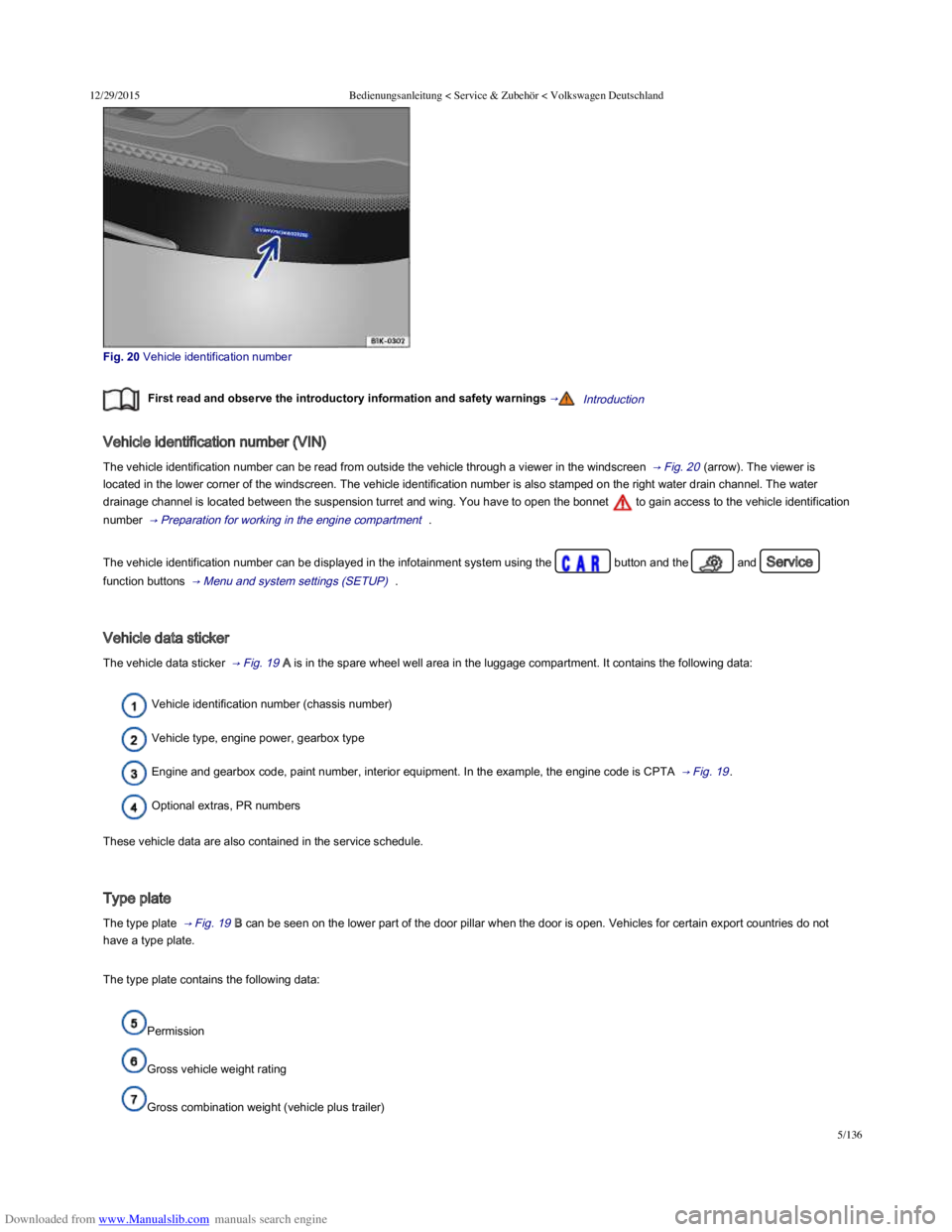
Downloaded from www.Manualslib.com manuals search engine 12/29/2015Bedienungsanleitung < Service & ZubehûÑr < Volkswagen Deutschland
5/136
Fig.ô 20ô Vehicleô identificationô number
Firstô readô andô observeô theô introductoryô informationô andô safetyô warningsô ãIntroductionã₤
Vehicle identification number (VIN)
The vehicle identification number can be read from outside the vehicle through a viewer in the windscreen ô ãô Fig.ô 20ã₤ (arrow). The viewer is
located in the lower corner of the windscreen. The vehicle identification number is also stamped on the right water drain channel. The water
drainage channel is located between the suspension turret and wing. You have to open the bonnet to gain access to the vehicle identification
number ô ãô Preparation for working in the engine compartment ã₤ .
The vehicle identification number can be displayed in the infotainment system using the button and the and Service
function buttons ô ãô Menu and system settings (SETUP) ã₤ .
Vehicle data sticker
The vehicle data sticker ô ãô Fig.ô 19ã₤ô A is in the spare wheel well area in the luggage compartment. It contains the following data:
Vehicle identification number (chassis number)
Vehicle type, engine power, gearbox type
Engine and gearbox code, paint number, interior equipment. In the example, the engine code is CPTA ô ãô Fig.ô 19ã₤.
Optional extras, PR numbers
These vehicle data are also contained in the service schedule.
Type plate
The type plate ô ãô Fig.ô 19ã₤ô B can be seen on the lower part of the door pillar when the door is open. Vehicles for certain export countries do not
have a type plate.
The type plate contains the following data:
Permission
Gross vehicle weight rating
Gross combination weight (vehicle plus trailer)
Page 48 of 100
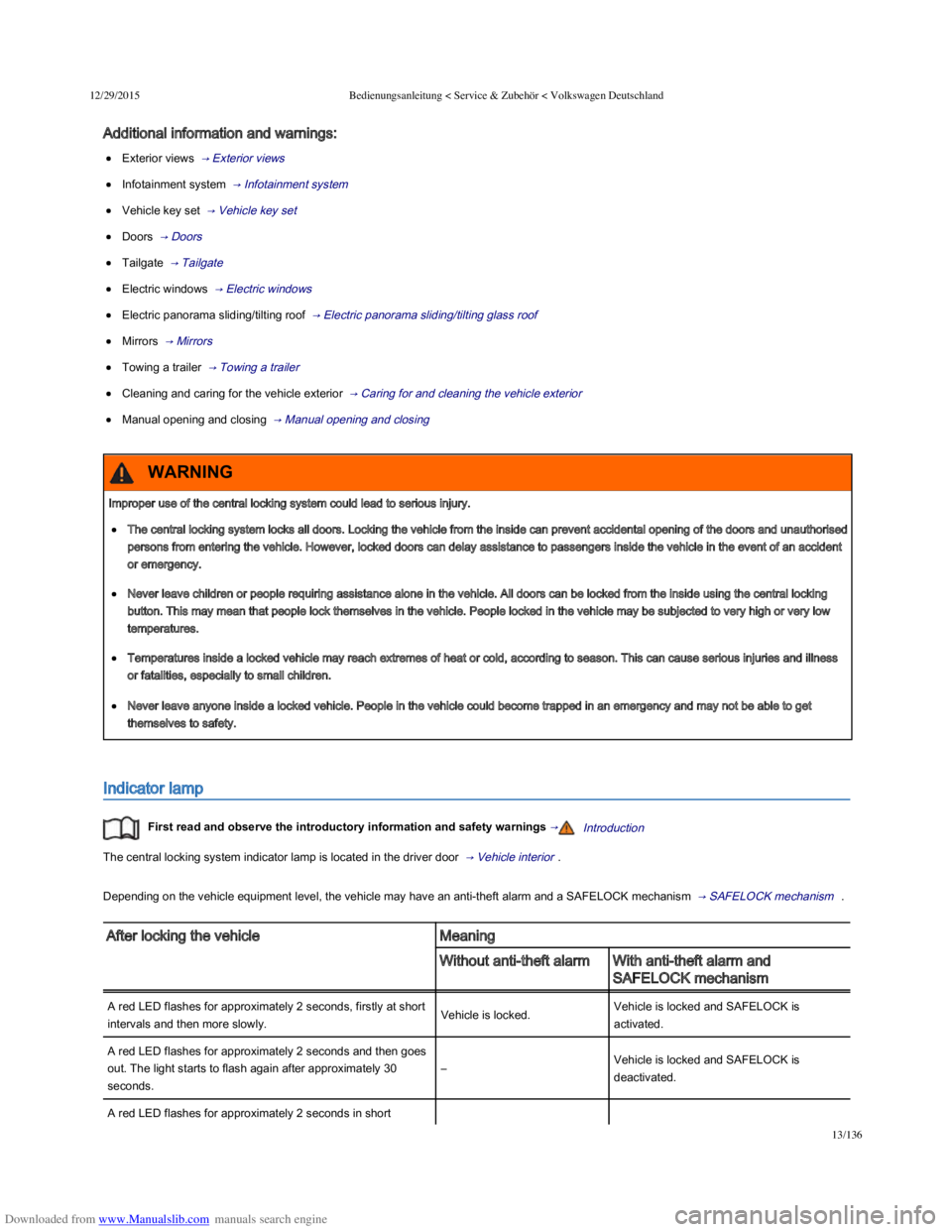
Downloaded from www.Manualslib.com manuals search engine 12/29/2015Bedienungsanleitung < Service & ZubehûÑr < Volkswagen Deutschland
13/136
Additional information and warnings:
Exterior views ô ãô Exterior views ã₤
Infotainment system ô ãô Infotainment systemã₤
Vehicle key set ô ãô Vehicle key set ã₤
Doors ô ãô Doors ã₤
Tailgate ô ãô Tailgate ã₤
Electric windows ô ãô Electric windows ã₤
Electric panorama sliding/tilting roof ô ãô Electric panorama sliding/tilting glass roof ã₤
Mirrors ô ãô Mirrors ã₤
Towing a trailer ô ãô Towing a trailer ã₤
Cleaning and caring for the vehicle exterior ô ãô Caring for and cleaning the vehicle exterior ã₤
Manual opening and closing ô ãô Manual opening and closing ã₤
Indicator lamp
Firstô readô andô observeô theô introductoryô informationô andô safetyô warningsô ãIntroductionã₤
The central locking system indicator lamp is located in the driver door ô ãô Vehicle interiorã₤ .
Depending on the vehicle equipment level, the vehicle may have an anti-theft alarm and a SAFELOCK mechanism ô ãô SAFELOCK mechanism ã₤ .
After locking the vehicleMeaning
Without anti-theft alarmWith anti-theft alarm and
SAFELOCK mechanism
A red LED flashes for approximately 2ô seconds, firstly at short
intervals and then more slowly.Vehicle is locked.Vehicle is locked and SAFELOCK is
activated.
A red LED flashes for approximately 2 seconds and then goes
out. The light starts to flash again after approximately 30
seconds.
ãVehicle is locked and SAFELOCK is
deactivated.
A red LED flashes for approximately 2ô seconds in short
Improper use of the central locking system could lead to serious injury.
The central locking system locks all doors. Locking the vehicle from the inside can prevent accidental opening of the doors and unauthorised
persons from entering the vehicle. However, locked doors can delay assistance to passengers inside the vehicle in the event of an accident
or emergency.
Never leave children or people requiring assistance alone in the vehicle. All doors can be locked from the inside using the central locking
button. This may mean that people lock themselves in the vehicle. People locked in the vehicle may be subjected to very high or very low
temperatures.
Temperatures inside a locked vehicle may reach extremes of heat or cold, according to season. This can cause serious injuries and illness
or fatalities, especially to small children.
Never leave anyone inside a locked vehicle. People in the vehicle could become trapped in an emergency and may not be able to get
themselves to safety.
WARNING
Page 53 of 100
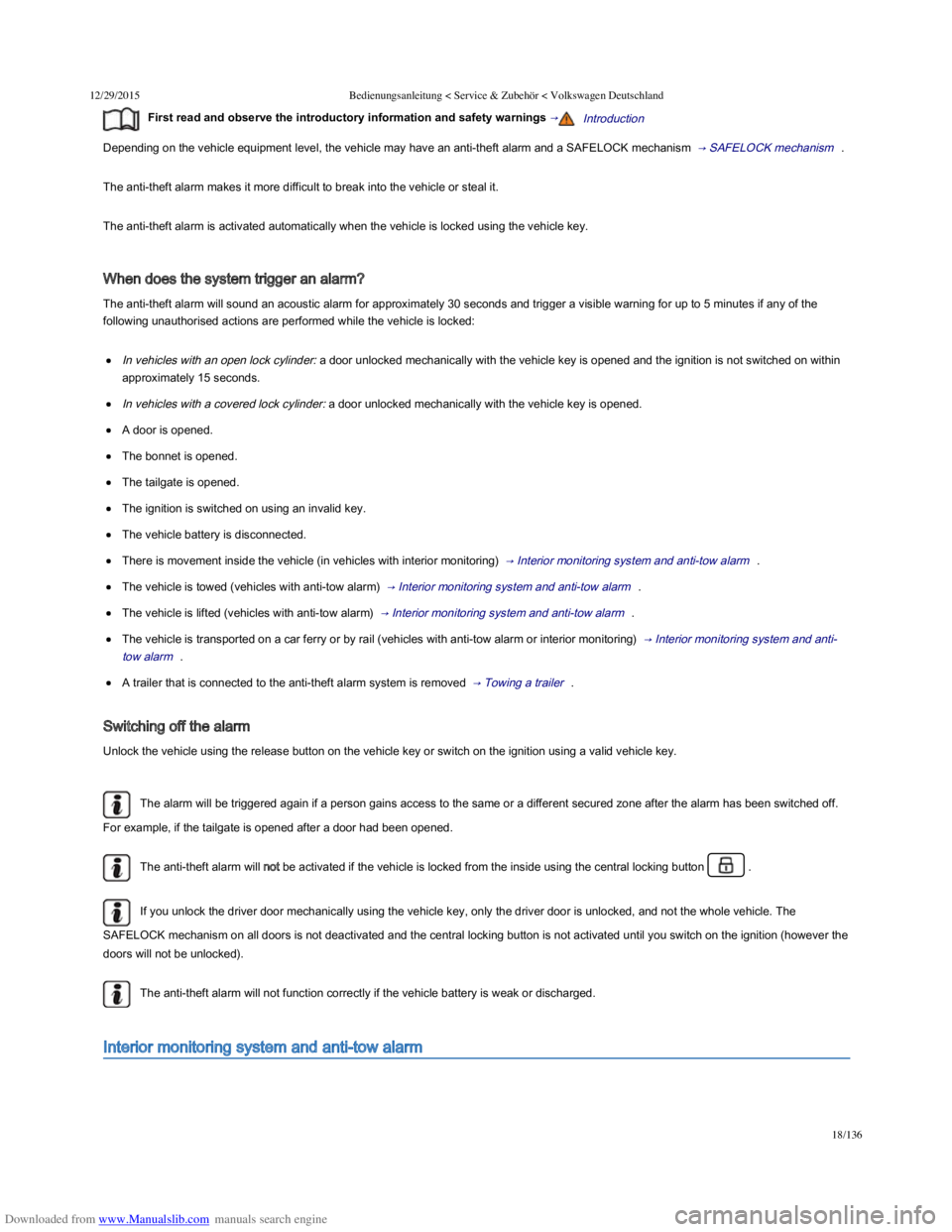
Downloaded from www.Manualslib.com manuals search engine 12/29/2015Bedienungsanleitung < Service & ZubehûÑr < Volkswagen Deutschland
18/136
Firstô readô andô observeô theô introductoryô informationô andô safetyô warningsô ãIntroductionã₤
Depending on the vehicle equipment level, the vehicle may have an anti-theft alarm and a SAFELOCK mechanism ô ãô SAFELOCK mechanism ã₤ .
The anti-theft alarm makes it more difficult to break into the vehicle or steal it.
The anti-theft alarm is activated automatically when the vehicle is locked using the vehicle key.
When does the system trigger an alarm?
The anti-theft alarm will sound an acoustic alarm for approximately 30 seconds and trigger a visible warning for up to 5 minutes if any of the
following unauthorised actions are performed while the vehicle is locked:
In vehicles with an open lock cylinder: a door unlocked mechanically with the vehicle key is opened and the ignition is not switched on within
approximately 15 seconds.
In vehicles with a covered lock cylinder: a door unlocked mechanically with the vehicle key is opened.
A door is opened.
The bonnet is opened.
The tailgate is opened.
The ignition is switched on using an invalid key.
The vehicle battery is disconnected.
There is movement inside the vehicle (in vehicles with interior monitoring) ô ãô Interior monitoring system and anti-tow alarm ã₤ .
The vehicle is towed (vehicles with anti-tow alarm) ô ãô Interior monitoring system and anti-tow alarm ã₤ .
The vehicle is lifted (vehicles with anti-tow alarm) ô ãô Interior monitoring system and anti-tow alarm ã₤ .
The vehicle is transported on a car ferry or by rail (vehicles with anti-tow alarm or interior monitoring) ô ãô Interior monitoring system and anti-
tow alarm ã₤ .
A trailer that is connected to the anti-theft alarm system is removed ô ãô Towing a trailer ã₤ .
Switching off the alarm
Unlock the vehicle using the release button on the vehicle key or switch on the ignition using a valid vehicle key.
The alarm will be triggered again if a person gains access to the same or a different secured zone after the alarm has been switched off.
For example, if the tailgate is opened after a door had been opened.
The anti-theft alarm will not be activated if the vehicle is locked from the inside using the central locking buttonô .
If you unlock the driver door mechanically using the vehicle key, only the driver door is unlocked, and not the whole vehicle. The
SAFELOCK mechanism on all doors is not deactivated and the central locking button is not activated until you switch on the ignition (however the
doors will not be unlocked).
The anti-theft alarm will not function correctly if the vehicle battery is weak or discharged.
Interior monitoring system and anti-tow alarm
Page 58 of 100
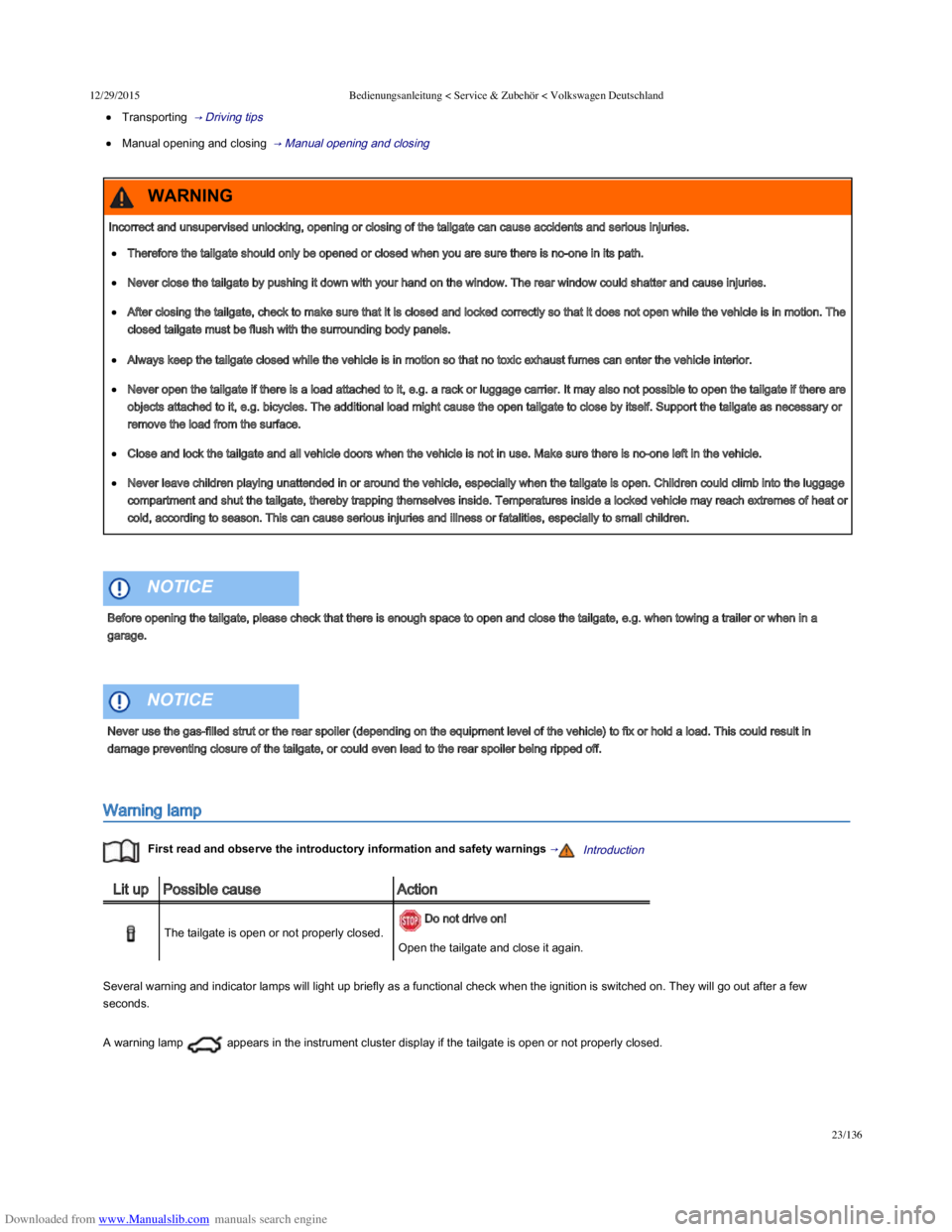
Downloaded from www.Manualslib.com manuals search engine 12/29/2015Bedienungsanleitung < Service & ZubehûÑr < Volkswagen Deutschland
23/136
Transporting ô ãô Driving tips ã₤
Manual opening and closing ô ãô Manual opening and closing ã₤
Warning lamp
Firstô readô andô observeô theô introductoryô informationô andô safetyô warningsô ãIntroductionã₤
Lit upPossible causeAction
The tailgate is open or not properly closed.
Do not drive on!
Open the tailgate and close it again.
Several warning and indicator lamps will light up briefly as a functional check when the ignition is switched on. They will go out after a few
seconds.
A warning lamp appears in the instrument cluster display if the tailgate is open or not properly closed.
Incorrect and unsupervised unlocking, opening or closing of the tailgate can cause accidents and serious injuries.
Therefore the tailgate should only be opened or closed when you are sure there is no-one in its path.
Never close the tailgate by pushing it down with your hand on the window. The rear window could shatter and cause injuries.
After closing the tailgate, check to make sure that it is closed and locked correctly so that it does not open while the vehicle is in motion. The
closed tailgate must be flush with the surrounding body panels.
Always keep the tailgate closed while the vehicle is in motion so that no toxic exhaust fumes can enter the vehicle interior.
Never open the tailgate if there is a load attached to it, e.g. a rack or luggage carrier. It may also not possible to open the tailgate if there are
objects attached to it, e.g. bicycles. The additional load might cause the open tailgate to close by itself. Support the tailgate as necessary or
remove the load from the surface.
Close and lock the tailgate and all vehicle doors when the vehicle is not in use. Make sure there is no-one left in the vehicle.
Never leave children playing unattended in or around the vehicle, especially when the tailgate is open. Children could climb into the luggage
compartment and shut the tailgate, thereby trapping themselves inside. Temperatures inside a locked vehicle may reach extremes of heat or
cold, according to season. This can cause serious injuries and illness or fatalities, especially to small children.
WARNING
Before opening the tailgate, please check that there is enough space to open and close the tailgate, e.g. when towing a trailer or when in a
garage.
NOTICE
Never use the gas-filled strut or the rear spoiler (depending on the equipment level of the vehicle) to fix or hold a load. This could result in
damage preventing closure of the tailgate, or could even lead to the rear spoiler being ripped off.
NOTICE